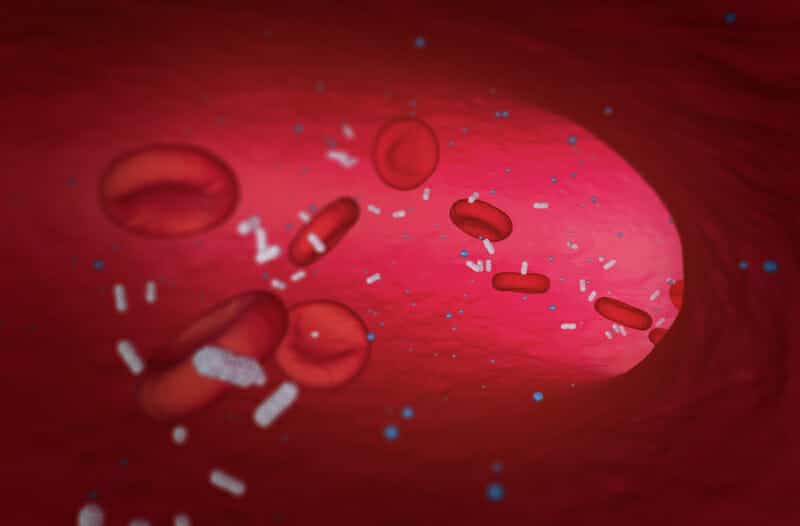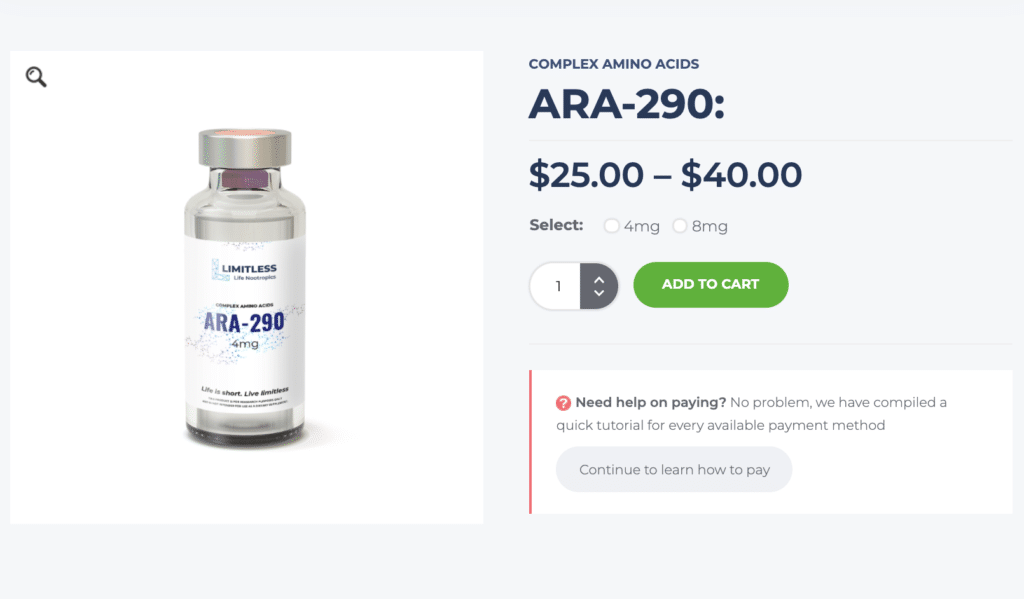Is ARA-290 the best peptide for treating severe levels of pain?
Pain is a normal part of our daily lives… until it gets out of control and interferes with our ability to function as normal human beings.
According to the Centers for Disease Control and Prevention:
“Chronic pain has been linked to numerous physical and mental conditions and contributes to high health care costs and lost productivity. A limited number of studies estimate that the prevalence of chronic pain ranges from 11% to 40%.
In 2016, an estimated 20.4% of U.S. adults had chronic pain and 8.0% of U.S. adults had high-impact chronic pain. Both were more prevalent among adults living in poverty, adults with less than a high school education, and adults with public health insurance.”
To put that into further perspective: The National Institutes of Health states that “an estimated 25.3 million adults (11.2 percent) had pain every day for the preceding 3 months” and “nearly 40 million adults (17.6 percent) experience severe levels of pain”
So can the ARA-290 peptide be the magical solution to a growing problem across the nation?
Can it provide other health benefits besides alleviating severe levels of pain?
And where exactly can you buy high-quality ARA-290?
This article will answer all of those questions, and much more!
Table of Contents
ToggleWhat is ARA-290?

ARA-290 (a.ka. Cibinetide) is a synthetic peptide developed by Araim Pharmaceuticals that consists of 11 amino acids and is entirely derived from the helix beta domain of erythropoietin (EPO).
And in case you don’t know the role of EPO in your body:
“Erythropoietin (EPO) is a glycoprotein hormone, naturally produced by the peritubular cells of the kidney, that stimulates red blood cell production. EPO production also occurs in the spleen, liver, bone marrow, lung, and brain in small quantities.”
If you look up what ARA-290 is most commonly used for, you’ll notice the disease state known as “sarcoidosis” frequently come up:
“Sarcoidosis is a multi-system, chronic, inflammatory, orphan disease… affects multiple organ systems causing localized non-caseating granulomas. The lungs (> 90%) and lymphatic system are most frequently afflicted followed in frequency by involvement of cardiac, neuronal, ocular, renal, and skin tissues.”
” In some patients the disease develops asymptomatically; in others the disease has an insidious course, which often results in a chronic relapsing form with pain and fatigue as important symptoms. In patients with an acute onset of the disease symptoms include fatigue, fever, weight loss, night sweats, erythema nodosum and a dry cough”
Currently, the ARA-290 peptide is still in the middle of Phase II clinical trials for treating the following indications: Diabetic neuropathy, neuropathic pain, sarcoidosis, and rheumatoid arthritis.
However, the FDA currently recognizes ARA-290 as an orphan drug for the treatment of sarcoidosis-induced neuropathic pain.
ARA-290 Mechanism of Action

ARA-290 was primarily developed due to Ariam Pharmaceuticals’ discovery of the Innate Repair Receptor (IRR), a key target for lowering chronic inflammation while activating tissue repair.
As it turns out, EPO already binds to the IRR and activates several anti-inflammatory pathways:
“The IRR is typically not expressed by normal tissues, but rather is locally upregulated in response to tissue injury, hypoxia, or metabolic stress. Because the affinity of EPO for the receptor is low, high local concentrations of EPO are required at the site of injury. Activation of the IRR simultaneously actives anti-inflammatory and tissue repair pathways”
Unfortunately, efforts to use human EPO have not been successful in treating inflammation or other forms of neuropathic pain:
“…clinical studies indicate that the use of recombinant EPO is associated with serious side effects, such as arterial and venous thrombosis, hypertension, stroke, and myocardial infarction. Hence, the use of exogenous EPO has not been pursued seriously in clinical studies requiring extended dosing”
So in order to circumvent this issue, an analog was needed that would selectively target the IRR and nothing else, and this is how ARA-290 came to be:
“ARA 290 produces its effects via activation of the β-common-receptor. The β-common-receptor in conjunction with the EPO receptor forms a heterocomplex (designated the innate repair receptor, IRR), which becomes locally up-regulated following tissue injury
Its activation initiates a local anti-inflammatory response, inhibition of death signal and anti-apoptosis, thereby preventing overt tissue damage.
Additionally, activation of the IRR also promotes tissue repair responses, including neurite outgrowth in the nervous system.”
In other words, ARA-290 provides all the therapeutic effects of EPO without the over-production of red blood cells or the other unwanted side effects:
“… contrast to rhEPO that has shown side effects in clinical trials, to date ARA 290 has been shown to be safe when formally evaluated in preclinical animal toxicology, normal human volunteers and patients with sarcoidosis”
So how exactly can the ARA-290 peptide be used to help us live a life free of pain and inflammation?
Top 4 ARA-290 Benefits

Despite only having a total of 45 published studies since 2012 (Source: PubMed), ARA-290 carries numerous health benefits for anybody suffering from severe pain and/or chronic inflammation.
It is still in its experimental stages and has yet to receive FDA approval, but this does NOT make it any less potent or effective.
Pain Management
In 2016, a new mechanism was discovered which could explain ARA-290’s primary benefit of pain management and relief:
“In this study, we are particularly interested in whether ARA 290 could directly target peripheral nociceptors by blocking or influencing receptors in pain sensation. Using calcium imaging, cell culture and behavioral tests, we demonstrated that ARA 290 was able to specifically inhibit TRPV1 channel activity, and relieve the mechanical hypersensitivity induced by capsaicin.”
But even before then, several smaller clinical studies found that ARA-290 had significant pain reduction effects:
“This phase 2b, 28-day, randomized trial of 64 subjects with sarcoid-associated SNFL [small nerve fiber loss] and neuropathic pain assessed the effect of cibinetide on corneal nerve fiber area (CNFA) and regenerating intraepidermal fibers (GAP-43+) as surrogate endpoints for disease modification, pain severity, and functional capacity”
“…Pain improved significantly in all groups, with subjects having moderate-severe pain reporting a clinically meaningful placebo-corrected decrease in pain intensity in the 4 mg group” (Source)
“The ARA 290 group showed significant (p < 0.05) improvement at wk 4 in small fiber neuropathy screening list score compared with placebo.”
Additionally, the ARA 290 group showed a significant change from baseline in the pain and physical functioning dimensions of the SF-36. The mean Brief Pain Inventory and Fatigue Assessment Scale scores improved significantly but equivalently in both patient groups” (Source)
All in all, the ARA-290 peptide is very helpful for neuropathic pain (i.e. hypersensitivity to pain for no apparent reason).
As evidenced by the trials… you can use it for 30 days and pain will become near non-existent within 6 months due to the decreased reactivity of nerve cells.
Helps Lower Chronic Inflammation
ARA-290 also plays a critical role in downregulating inflammation, which is crucial when you consider that high-inflammatory stress conditions tend to have severe pain as a major symptom:
“Secretion of pro-inflammatory cytokines (IL-6, IL-12, and TNF-α) from macrophages was significantly inhibited by ARA 290.
…Upregulation of monocyte chemoattractant protein-1, macrophage inflammatory protein-1β, IL-1β, and IL-6 messenger RNA expression within the liver was suppressed by ARA 290 treatment.”
These same findings are also observed during islet transplants, an operational procedure by which normal insulin production is restored in diabetic patients:
“The treatment with cibinetide reduced inflammatory responses, shown by significantly low mRNA expression of IL-1 and IL-6 in the recipient liver harvested at 16 hours after ITx, and prolonged islet allograft survival time compared to those of control group animals”
“…Cibinetide protects human islets from inflammatory damage. Suppression of initial inflammatory reactions by cibinetide protects islets, and also reduces subsequent allo-immune responses.”
Even when the islet transplant itself is unsuccessful, ARA-290 serves a useful role in “reducing islet injury caused by severe inflammation” (Source).
Like I continue to say over and over again… chronic inflammation is the ROOT CAUSE of all modern-day diseases!
Can Restore Poor Markers of Health in Diabetic Patients
In type 2 diabetics, the ARA-290 peptide can do much more than lower the symptoms of neuropathic pain… it can also restore several key biomarkers of good health:
“To evaluate the potential activity of ARA 290 in type 2 diabetes and painful neuropathy, subjects were enrolled in this phase 2 study. ARA 290 (4 mg) or placebo were self-administered subcutaneously daily for 28 d and the subjects followed for an additional month without further treatment”
“Subjects receiving ARA 290 exhibited an improvement in hemoglobin A1c (Hb A1c) and lipid profiles throughout the 56 day observation period. Neuropathic symptoms as assessed by the PainDetect questionnaire improved significantly in the ARA 290 group”
Another hallmark feature of diabetes is reduced speed and effectiveness of wound healing, a process which ARA-290 was proven to accelerate in a 2017 preclinical study involving diabetic mice:
“…improve[d] wound healing in a diabetic mouse model by accelerating wound closure, promoting blood vessel growth, and increasing the strength of the healing tissue”
“…[innate repair receptor] activation by cibinetide (a.k.a. ARA-290) accelerates diabetic wound healing via multiple biological pathways, resulting in increased protein synthesis, new blood vessel growth, and reduced oxidative stress”
This discovery was previously found two years prior in mice with type 1 diabetes, who needed pancreatic islet cell transplantation in order to normalize their blood glucose levels:
“Pancreatic islet cell transplantation (PITx) is an experimental treatment option for patients with brittle type 1 diabetes characterized by frequent bouts of hypoglycaemia. When transplants are successful, they can result in normalised glucose without the need for insulin injections.”
“Following ARA 290 administration, macrophage activation, secretion of pro-inflammatory cytokines (IL-6, IL-12, and TNF-alpha), and activation of pro-inflammatory cytokine mRNA expression in the liver were all suppressed.
The compound protected islets from cytokine-induced damage and cell death, leading to improved islet graft function. Blood glucose levels were significantly decreased in the compound-treated diabetic mice compared to control animals throughout the post-transplant period.”
Nerve Repair and Regeneration
ARA-290’s pain-relieving abilities can be attributed to its ability to restore the number of nerves, along with the connective strength between each nerve:
“The Phase 2b trial included 64 sarcoidosis patients with painful neuropathy to investigate the safety and effectiveness of daily subcutaneous cibinetide treatment (at a dose of 1, 4, or 8 mg) compared to placebo for 28 days.
…Researchers found that treatment with cibinetide provided a significant increase (23 percent) in the corneal nerve fiber abundance in patients taking the 4 mg dose, compared to placebo.
As patients presented nerve fiber regeneration, they also experienced improved functional activity. Patients with moderate to severe pain at the start of the study reported a clinically meaningful decrease in pain intensity. There were no safety issues reported during the study.”
Injecting 2 mg of ARA-290 subcutaneously once per day for 4 weeks straight also leads to functional recovery, primarily through physical movement that is less painful:
“In addition to improved patient-reported symptom-based outcomes, ARA 290 administration was also associated with a significant increase in corneal small nerve fiber density, changes in cutaneous temperature sensitivity, and an increased exercise capacity as assessed by the 6-minute walk test”
Thus, the end result for the patient using ARA-290 is “improved sensory pain thresholds [and] improved quality of life and physical functioning” (Source).
Other Possible ARA-290 Benefits
Due to the novelty of ARA-290, pain relief and inflammation reduction may only be scratching the surface of its true health-optimizing capabilities.
Although these use cases are not definitively proven, they are worth further examination by any scientist with an interest in therapeutic peptides:
- Increased efficiency in oxygen utilization (“It’s like having a third lung” – Ben Greenfield)
- May exert antidepressant effects in young, healthy adults
- Could assist in preventing the development of “emphysema” (i.e. damaged air sacs in your lungs)
- Improves healthspan (i.e. number of years you live in full health) while reducing age-associated declines in heart structure and function
There’s a bright future ahead for the ARA-290 peptide, assuming it doesn’t get suppressed into non-existence as other peptides have in recent years.
ARA-290 Dosage for Rapid Pain Relief

So what is the best dose of the ARA-290 peptide for pain relief, whether as a healthy individual or someone suffering from neuropathic pain.
I highly recommend a 0.33 mL daily subcutaneous injection of a 4 mg/mL ARA-290 solution (i.e. 1.32 mg per day) for a total of 30 days.
Some people suffering from more severe levels of pain go as high as 4 mg per day for a total of 30 days, expecting the benefits of lowered inflammation and reduced pain to last up to 6 months.
Either way, you should expect the benefits to start kicking in around 2-3 weeks into your daily injection protocol.
This recommendation directly lines up with the clinical studies quoted so far in terms of the quantity of ARA-290 dosage, the dosing schedule, and expected treatment outcomes.
ARA-290 Side Effects and Safety Profile

Despite its young age as an experimental peptide, there has yet to be a single study demonstrating any unwanted ARA-290 side effects or toxicity.
A 2014 review of two separate Phase II clinical studies made the following discovery:
“ARA 290 treatment was consistently associated with a significant improvement of neuropathic pain symptoms in sarcoidosis patients, evidenced by a decrease in pain scores on validated questionnaires.”
“…Given the excellent safety profile while reducing neuropathy symptoms, the prospects of ARA 290 treatment in sarcoid neuropathy seem promising.
The long-lasting beneficial effects of ARA 290 on both pain-related and non-pain-related symptoms in sarcoidosis patients prompt additional studies on potential disease-modifying properties of ARA 290.”
And if you look at the fine details of every single study quoted in this article, you will be hard-pressed to find any severe side effects that would otherwise necessitate the immediate termination of ARA-290 treatment.
With all of this being said, ARA-290 is classified as a research chemical and is NOT marked for human consumption.
You are ultimately responsible for the proper use of ARA-290 and any benefits – or side effects – that occur as a result.
Where to Buy ARA-290

SInce ARA-290 is a much lesser known compound, there are far fewer vendors in existence who even know about this peptide… much less stack it on their shelves for distribution.
Therefore, you need to exercise extreme caution and do your due diligence before you buy ARA-290 from any peptides vendor.
As always, Limitless Life Nootropics is the ONLY place I know where you can source pharmaceutical-grade ARA-290 without breaking the bank.
Use code JAY15 to get 15% off your order!
Every single peptide sold by this vendor is independently tested by a third-party analytical laboratory before it gets featured on the website, and ARA-290 is no exception to this promise.
Additional Reading Resources for ARA-290

There are very few legitimate resources available for learning more about the ARA-290 peptide.
Not only is it used for specific health needs, but it is not nearly as well-researched compared to other therapeutic peptides I’ve featured on this website.
Nevertheless, here are some materials I highly recommend reading through if you want to dive deeper into the wonders of ARA-290…
Dr. Elizabeth Yurth, one of the world’s smartest peptide physicians, did an entire podcast with Super Human Radio about using ARA-290 to treat neuropathy, neuralgia, and fibromyalgia (click here for the transcript).
This Google Drive folder contains an EPIC collection of every single published study on ARA-290.
The Foundation for Sarcoidosis Research published a webinar in 2017 on how ARA-290 was used to treat small fiber neuropathy (includes transcript).
Finally, this informative podcast is a deep dive into the use of ARA-290 for nerve regeneration.
And as always…
Raise Your Vibration To Optimize Your Love Creation!
Subscribe to my email list so you can get exclusive access to the world’s best health optimization intel before anybody else finds out about it!



